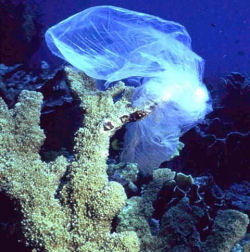 I was in the bookstore the other day and started skimming through a book called “The Toxic Sandbox.” It’s geared toward parents concerned with the chemicals and pollutants that are effecting children as early as inside the womb. I spent most of my time reading the chapter about plastics. It really has reinforced my want to get the most plastics possible out of my life. My first step was over a year ago when I purchased the reusable, collapsable bags from my local grocery store. They are well-made, hold a lot of weight and I keep a few in my car and home at all times. At my local Surfrider Foundation meeting the other night we talked about a campaign against plastics- not just bags, but bottles, take-out food containers, plastic cutlery, etc. A little lightbulb went off in my head and I realized I had managed to stop using plastic at the grocery store, but I was still guilty of accepting bags from Target and other similar stores.                 (Image note: that’s a bag not a jellyfish! Photo from NOAA)
I was in the bookstore the other day and started skimming through a book called “The Toxic Sandbox.” It’s geared toward parents concerned with the chemicals and pollutants that are effecting children as early as inside the womb. I spent most of my time reading the chapter about plastics. It really has reinforced my want to get the most plastics possible out of my life. My first step was over a year ago when I purchased the reusable, collapsable bags from my local grocery store. They are well-made, hold a lot of weight and I keep a few in my car and home at all times. At my local Surfrider Foundation meeting the other night we talked about a campaign against plastics- not just bags, but bottles, take-out food containers, plastic cutlery, etc. A little lightbulb went off in my head and I realized I had managed to stop using plastic at the grocery store, but I was still guilty of accepting bags from Target and other similar stores.                 (Image note: that’s a bag not a jellyfish! Photo from NOAA)
I am now researching all the ways I use plastic in my life and what within reason can I get rid of. Did you know your plastic shower curtain is full of pollutants, or when you nuke cling-wrap covered food in your microwave you are cooking chemicals right into your food? I’m no expert on plastics, but I am definitely concerned enough to try and find an alternative wherever possible. I would love to hear any ideas on how you have stopped using plastics. Glass jars for storing food items? A cloth sack for produce? What can we use in place of Zip-locks?
Funny that I should be blogging on plastics, as just a few minutes ago I coincidentally received this message from StopGlobalWarming.org :
New York’s City Council passed a bill requiring large stores and retail chains to collect and recycle plastic shopping bags. According to a New York Times report: “New York is by far the largest American city to enact so broad a measure to limit the environmental impact of the bags. Altogether, each year the country is estimated to use 86 billion bags, which end up blowing down city streets, or tangled in the stomachs of whales, sea turtles and birds, or buried in landfills where they enjoy free rent for 1,000 years.”
Other cities like Melbourne and San Francisco have banned bags outright. San Francisco was the first city in North America to ban non-recyclable and non-biodegradable bags made from petroleum products. Africa has moved toward a continent-wide plastic bag ban, and just last week, China’s cabinet issued a directive banning their production, prohibiting stores from handing out free plastic bags after June 1st and imposing fees on their usage. People in China use up to 3 billion plastic bags daily! Help keep the momentum going here in the United States and just say no to plastic bags!
So maybe I’m on the right track. And I’m not stopping there. I have big issues with junk mail, disposable coffee cups, and what’s happening to China. But, for now, here are a few useful links regarding plastics
http://www.checnet.org/HealtheHouse/education/articles-detail.asp?Main_ID=24 http://www.mindfully.org/Plastic/Plasticizers/Out-Of-Diet-PG5nov03.htm













HEre are some great, relevant and alarming you tube vids
Patagonia Oceans As Wilderness- Synthetic Seas
http://www.youtube.com/watch?v=Verhi88kR60
The Garbage Patch
http://www.youtube.com/watch?v=tnUjTHB1lvM
The Plastic Vortex
http://www.youtube.com/watch?v=ZXVw19bP0tw&feature=related
Thanks to Rob Nelson of http://eastcoastaholic.com for forwarding these vids along!
Types of Plastic
* #1, PETE or PET (Polyethylene Terephthalate) — Used for clear beverage bottles. Widely recyclable; generaly considered safe, with some precautions.
* #2, HDPE (High-Density Polyethylene) — Used for colored or cloudy bottles and jugs, yogurt containers, and other tubs. Widely recyclable, but consumers need to verify with local recyclers whether tubs and bottles (which are made differently and can’t be recycled together) need to be separated. Generally considered safe, with some precautions.
* #3, PVC (Polyvinyl Chloride) — Used in some cling wrap and bottles, as well as pipes and other construction materials. Not widely recyclable; recommended to avoid because it can leach toxins into food and is an environmental problem throughout its lifecycle.
* #4, LDPE (Low-Density Polyethylene) — Used for garbage bags, food storage bags, and some cling wrap and bottles. Not widely recyclable; generally considered safe, with some precautions.
* #5, PP (Polypropylene) — Used in butter tubs, some baby bottles, and other rigid containers. Not widely recycled; generally considered safe.
* #6, PS (Polystyrene) — Used in foam trays, takeout containers, coolers, egg cartons, and packing peanuts. Not widely recyclable, although many packing and shipping stores accept packing peanuts for reuse. Recommended to avoid because styrene may leach into food and beverages.
* #7, Other (Includes Polycarbonate and mixed materials) — Used in five-gallon water bottles, some baby bottles, and some liners of metal cans. Not widely recyclable; recommended to avoid because bisphenol-A can leach from polycarbonate into food and beverages.